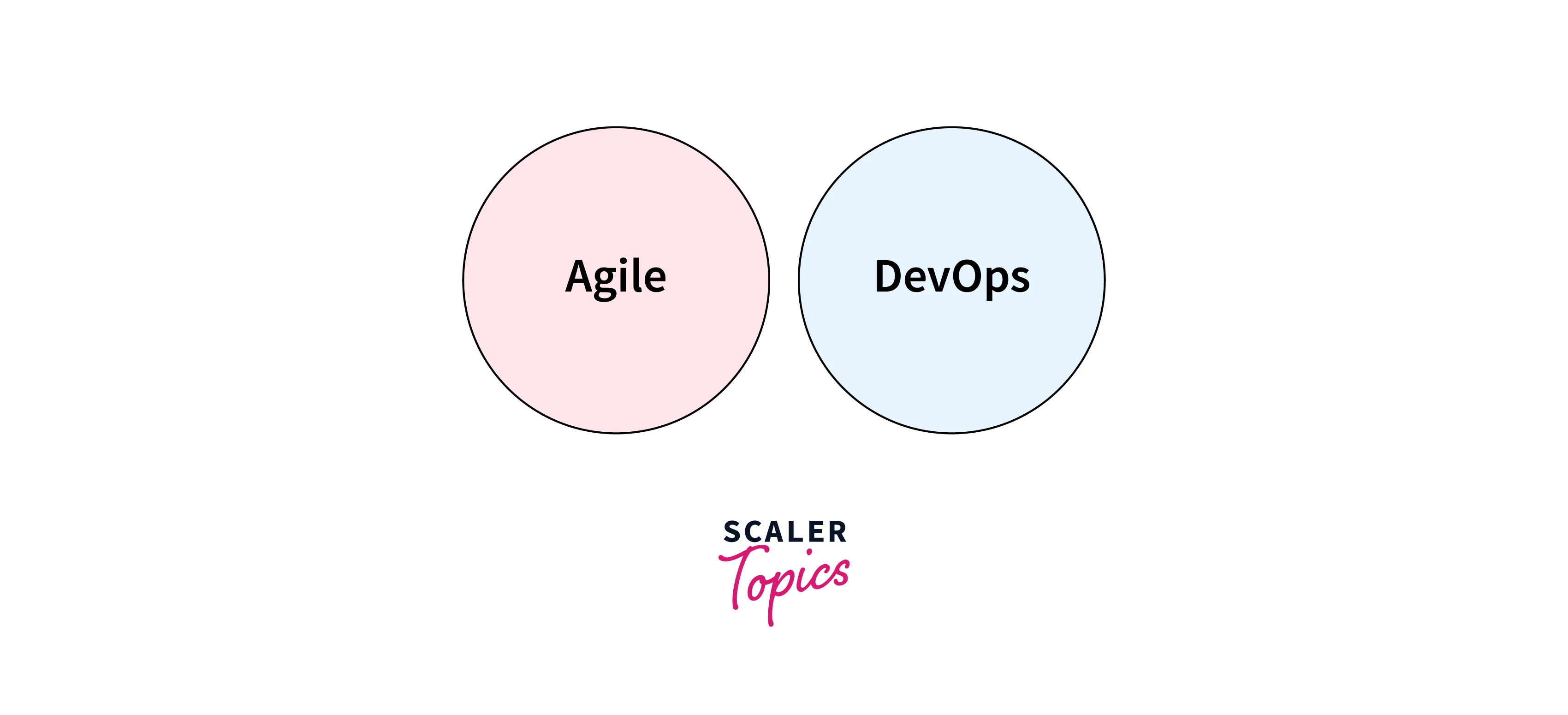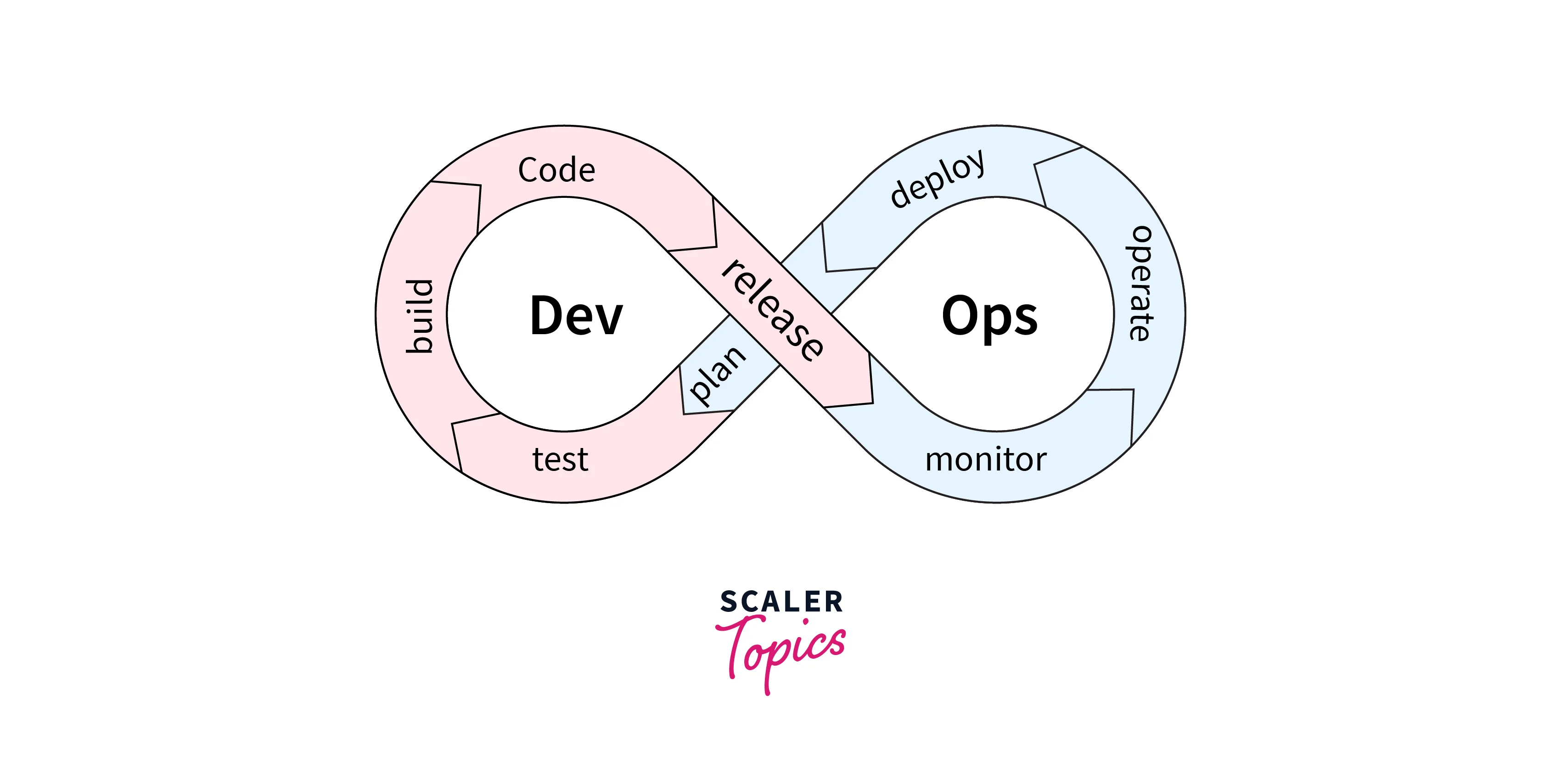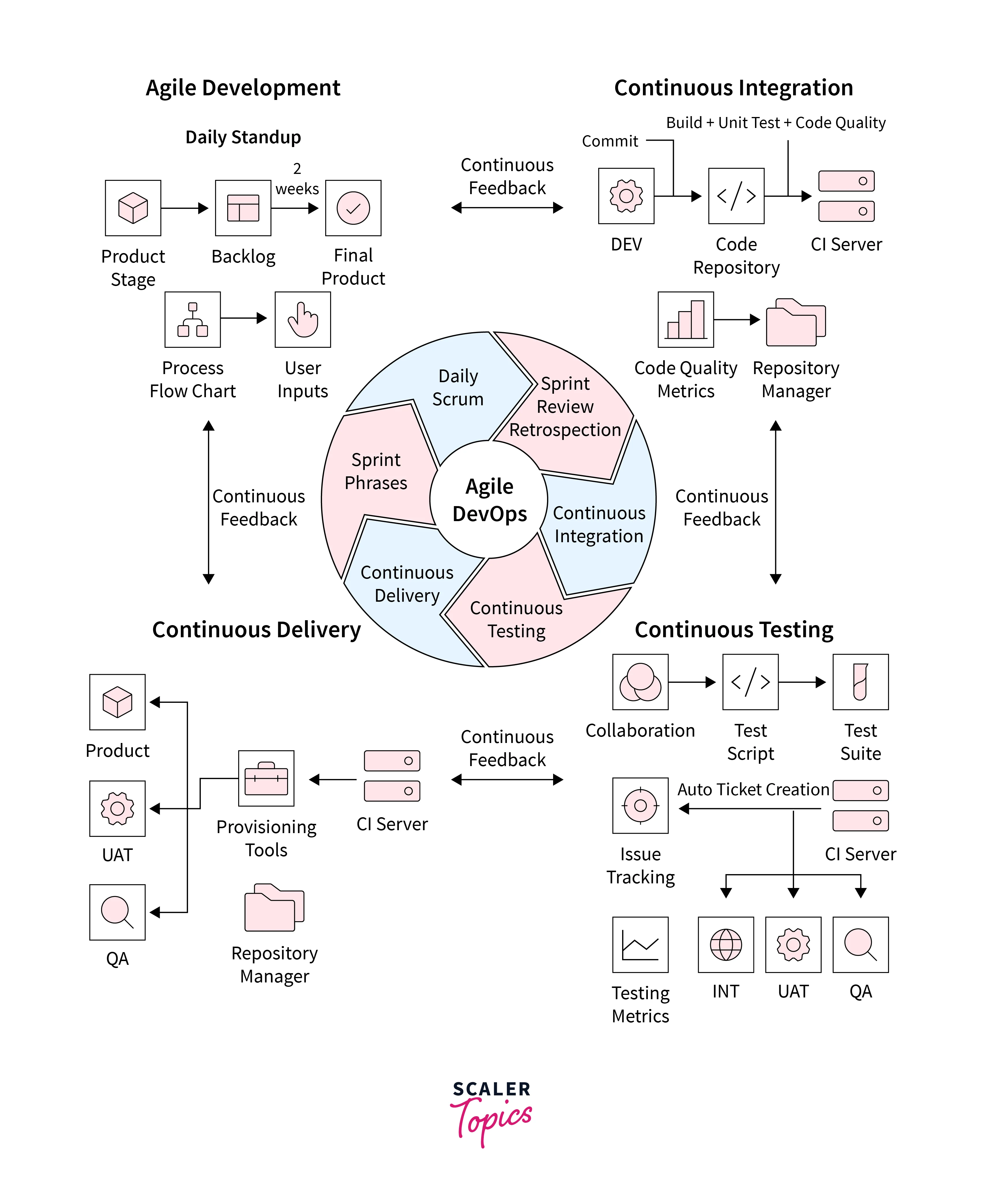How Agile and DevOps are Interrelated.
Exploring how Agile and DevOps interrelate, we see these methodologies as pivotal in modern software development. Agile, focusing on iterative, quick value delivery, and DevOps, emphasizing automated, collaborative operations, together accelerate software development and delivery. Agile's iterative testing reduces complexity, while DevOps automation minimizes bottlenecks. The Agile Development and tests Services Market is projected to reach $30 billion by 2026, reflecting Agile's effectiveness. Similarly, the DevOps market is expected to surpass $30 billion by 2028. Together, they reduce software discrepancies and downtime, fostering a strong QA industry. This synergy not only meets market demands but also manages outages and inconsistencies, proving that Agile and DevOps, while distinct, complement each other in enhancing software delivery and operational efficiency.

What is Agile?
Agile is a software development methodology that focuses on customer collaboration, fast delivery of working software, and delivering the product frequently. Agile was developed in response to the inefficiencies of the traditional, Waterfall-Style Software Development methodologies. Agile methodology is based on adaptability, early involvement of customers, and frequent delivery of working software. Instead of a large project plan that is created upfront and then followed, Agile breaks down the project into smaller, more manageable chunks. Agile also emphasizes the importance of collaboration between the customer and the team, which helps to ensure that the final product meets the customer's needs. Agile also encourages teams to self-organize and continuously inspect and adapt their processes to ensure that they are constantly improving their processes and products.
Benefits of Agile:
- Increased Flexibility : Agile methodology allows teams to respond to change quickly and easily. This means that teams can quickly adapt to changing requirements and customer needs, delivering better results faster.
- Improved Quality : Agile methodology focuses on delivering small increments of work regularly, which allows teams to identify and fix issues much faster than traditional methods. This leads to higher quality products and fewer issues overall.
- Increased Collaboration : Agile methodology encourages collaboration between teams and stakeholders. This makes it easier for teams to share ideas, build consensus, and make better decisions.
- Faster Delivery : Agile methodology allows teams to deliver results faster than traditional methods. This is because teams are focused on delivering small increments of work regularly rather than large, complex projects.
- Improved Visibility : Agile methodology provides visibility into progress and allows teams to track progress in real-time. This makes it easier for teams to identify potential issues and course-correct them as needed.

What is DevOps?
DevOps is an approach for software development that emphasizes collaboration, communication, integration, automation, and measurement of cooperation between software developers and other IT professionals. It is designed to improve the speed and quality of software development and delivery. It also reduces the cost and risk associated with software development.
DevOps is a combination of two words and they are “Development” and “Operations”, So we can say DevOps is a combination of these two to ensure proper communication and collaboration among the development teams. DevOps is focused on automating processes, such as the continuous integration and continuous delivery (CI/CD) of software. It uses a variety of tools and techniques to automate the deployment and testing of applications. It also helps to reduce the risk of software deployment by automating tests for software application stability and performance. It also promotes the scalability of systems, since the automated processes allow for faster and smoother deployments. This increases the ability of organizations to quickly respond to changes in demand.
Benefits of DevOps
- Improved Collaboration : DevOps ensures collaboration between Development and Operations teams. This helps to bridge the gap between them and reduce friction.
- Increased Efficiency : DevOps automates many of the manual processes and hence it helps to improve efficiency and speeds up the delivery process.
- Improved Quality : Automation in DevOps helps to reduce human errors and improves the quality of the software product.
- Faster Delivery : It helps to automate the entire process from the development level to production. The process of developing and deploying software is streamlined. This helps to reduce the time to market and deliver the product faster.
- Cost Savings : DevOps reduces manual efforts and hence helps to save costs. It also helps to reduce the time and cost associated with the project.
- Improved Security : DevOps helps to improve the security of the product by automating the security measures. This helps to reduce the chances of security breaches in software.
You can learn more about DevOps by Clicking Here.

How to do DevOps and Agile Interrelate with Each Other?
DevOps and Agile share a strong interconnection. So the answer of How do Agile and DevOps Interrelate? is, Agile is used to control software development while DevOps focuses on bringing the code into production and automation enhances the process. We can see that they both are different based on their approaches but they also aim for the same thing and that is: Effective Software Development and Delivery of Products High Quality. Software Development teams can speed up their development process by combining Agile Sprins with DevOps Automation. This will also improve the quality of the product. Let's look into some key points given below on How do DevOps and Agile interrelate with Each Other?:
- Continuous Integration (CI) : Continuous Integration and Continuous Delivery (or CI/CD) are used by Agile and DevOps to optimize the delivery lifecycle effectively. Agile ensures discrete bits of work that are connected into a coherent whole and on the other hand DevOps automates the code lifecycle to accelerate release deployments of products based on the business needs. They work simultaneously to create a safe, efficient and dependable pipeline. Some examples of CI/CD Tools are Jenkins, BitBucket, GitHub, Circle CI etc.
- Automation : Testing is done in both methodologies DevOps and Agile but in different ways. While Agile ensures specific skills from users to develop testing that assures quality, DevOps automates the repetitive testing using tools and ensures deployment compliance. Some Automation methods are CI, CD, IaC(Infrastructure as Code), Configuration Management, Test Automation etc.
- Modular Design : DevOps uses modular features like Git repositories and on the other hand Agile uses reusable and modular design concepts to create settings that encourage experimentation. DevOps containers are used to assist in the implementation of agile concepts at scale.
- Feedback : In Agile, sprints and scrum which ensure quick input from all stakeholders. In DevOps feedback is facilitated by identifying and automating errors. By using both Agile and DevOps Feedback cycles, the quality of the product increases up to the customer's expectations. JIRA is a tool used for this purpose.
- Development Flow : Agile focuses on the customer, while DevOps focuses on the development process. By combining the two, organizations can ensure that their development process is customer-driven, helping to create a better end product.

Technology Involving DevOps and Agile
Organizations utilize the development methodologies of Agile to ensure harness benefits like creativity and speed in DevOps. The Technology that encompasses both Agile and DevOps is Virtualization. Organizations can take better advantage of the Agile approach with DevOps by implementing Virtualization technology. Virtualization provides easily scaled approaches which leverage the benefits of both Agile and DevOps. Virtualization allows the continuous integration of DevOps and Agile by using Agile Development. Virtualization powers as many IT areas as possible. By using this SDLC process is speeded up while improving quality and customer satisfaction.
DevOps and Agile Software Lifecycle
Agile and DevOps are together involved in various SDLC (Software Development Life Cycle) Processes and they are as follows:
Planning, Coding and Building
DevOps is used to help Agile teams Plan, Code and Build software products faster. Automation Tools in DevOps can help speed up the coding, and building processes and allow developers to focus on testing and quality assurance.
Testing and Deployment
DevOps helps to automate the software testing process and allows agile teams to respond quickly to feedback received from customers. DevOps uses tools to help deployments to ensure that new features are released on time and quickly without any disruption.
Infrastructure Orchestration
It is easier to manage complex infrastructure using DevOps. DevOps allows Agile teams to deploy changes accurately and quickly. Visibility into DevOps processes and performance is provided using DevOps Tools. DevOps tools also help to prevent downtime and improve the experience of the customer.
Monitoring and Feedback
DevOps helps agile teams to monitor the performance of their product in real time and also allows them to recognise and eliminate potential issues before they even occur. It helps to prevent downtime and gives positive customer feedback and experience.
What is a Common Misconception About Agile and DevOps?
The very frequent and most common misconception about DevOps and Agile is that they are synonyms and can work alternately. While both Agile and DevOps share common principles and goals, they are distinct approaches with different focuses. Agile software development is designed to quickly deliver changes to customers as soon as possible and at regular intervals. This allows for more customer feedback and agile teams can quickly respond to customer requests. DevOps is an approach to software delivery that emphasizes automation and collaboration between development, operations, and other teams. DevOps enables teams to quickly deliver software changes and updates to customers without the need for manual processes. While Agile and DevOps share some principles, such as continuous improvement and customer focus, they have different objectives and approaches. Confusing them as interchangeable terms can lead to misunderstandings and misapplication of these practices, resulting in less-than-optimal outcomes. Ultimately, understanding the differences between Agile and DevOps is key to successfully integrating them into your software delivery strategy. Both approaches have unique advantages and should be used in the right context for maximum benefit.
Virtualization: Technology Involving DevOps and Agile
Virtualization offers common ground for both Agile and DevOps. It allows teams to develop and test in simulated environments while working together. In Virtualization, testing can run in parallel without making any changes that can affect the entire system in real-time. This level of testing accuracy helps to reduce deployment time and increases stability. DevOps can use containerization to set up a kernel that uses a single container for running multiple applications. Continuous delivery is possible through the flexible mechanism of virtualization and containerization technologies across many stable servers. Virtualization helps to achieve the core goals of Agile and DevOps.
Should you Incorporate DevOps and Agile in your Workflow?
Yes, incorporating DevOps and Agile into your workflow can help improve your development process. DevOps focuses on automation and collaboration between development and operations teams, while Agile emphasizes rapid, iterative development and delivery. By combining Agile and DevOps, organizations can create a culture of collaboration, automation, and continuous improvement that supports faster, higher-quality software development. This approach can lead to better alignment with customer needs, increased productivity, and improved business outcomes. However, it is important to note that incorporating Agile and DevOps requires a cultural shift in the organization, along with changes to processes and tooling. It may take time and effort to implement these practices effectively, and ongoing commitment to continuous improvement is necessary for sustained success.
Embark on a DevOps Journey: Bridge the Gap Between Development & Operations. Enroll in our DevOps Course for a Transformative Learning Experience!
Conclusion
- We now understand How to do Agile and DevOps Interrelate.
- DevOps is a technical continuation of Agile's initial vision.
- Agile is an iterative and incremental approach to software development.
- DevOps is an approach for software development that uses collaboration, communication, integration, automation, and measurement of cooperation between software developers and other IT professionals.
- Planning, Coding, Building, Testing and Deployment, Infrastructure Orchestration, Monitoring and Feedback are Agile and DevOps Lifecycle.
- The common misconception about DevOps and Agile is that they can work alternately but in reality, they both are different.
- The Technology involving both Agile and DeOps is Virtualization.
- We can incorporate DevOps and Agile in our workflow, Incorporating Agile and DevOps helps organizations in terms of collaboration, automation, quality improvement and faster delivery.
